page 16
Progressive Thinkers as of 5/8/2020
|
| ||||||||||||||||||||||||||||||||||||||||||||||||||||||||||||||||||||||||||||||||||||||||||||||||||||||||||||||||||||||||||||||||||||||||||||||||||||||
The point to be stressed is that while different patterns might be imagined from what materials are being observed, we see recurring themes of organization being used by the human mind, and that these themes exhibit low enumerations. We do not see complex ratios, fractions or whole numbers being used. In the case of decided multiplicity, the human mind once again resorts to a condensation and/or symbolic reduction, as if being forced to adopt such a recurrence as a needed survival mechanism. And despite claims of not wanting to be creatively limited, we nonetheless engage in restrictions which rely on repetitions of basic themes as if engaged in writing sequels or an associated volume in a series of a like-minded orientation. In short, we see nature repeating basic themes instead of engaging in a Universe-rich assortment of exploration.
For example, biology repeats the usage of a triple code in DNA instead of evolving towards the adoptions of some larger enumeration, though this may one day come about, if the environment permits it to occur. Likewise in terms of the quantity of elements in the Periodic table. There are not thousands, but merely a handful just over a hundred. In a supposed Universe of opportunity, it might seem rather foolish for Nature to engage in a recurring conservatism, unless from the Human range of perception and thinking, what we see is an outline of an existing limitation which the human body can not exceed, so long as it remains in its current biological form under the present planetary conditions. Basic themes of repetition appear to be a recurring "body plan" of human mental activity... suggesting a recurring set of environmental pressures that... if they should change abruptly, will cause a great deal of trauma for the human psyche. Predicting such a possibility may provide us with a manageable level of insight to increase our chances of survivability.
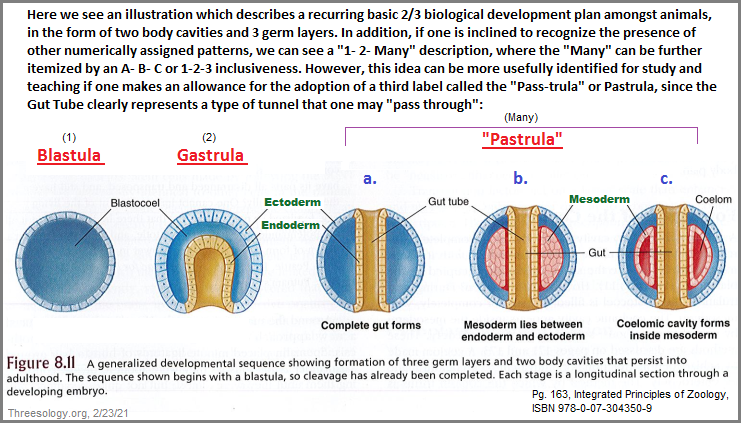
One of the patterns I am interested in is the origin of the pattern for all patterns... if such an entity exists and does not involve some simplistic reference such as a god or god particle. I have no intention nor desire to promote any religion or religious dogma. Another interest is in the consideration of whether or not there was (and perhaps still is?) an environmental pattern which caused the development of a triplet code in DNA (or perhaps I should say DNA's 3-to-ratio code). Was there an environmental occasion billions of years ago which initiated a developmentally occurring 1- 2 -3 pattern, even if researchers do not label nor even recognize such an underlying pattern and prefer to coin their own words and modeling diagram? Like religion and politics, science has a lot of arrogant and egotistical motivations behind its different subject matters. Curiously, what is causing DNA not to evolve as other processes have, unless it is but a point on a larger scale of interconnected activity like a cog in a very large wheel. Why keep life dependent on a so-called triplet code, unless it is an expressed pattern-of-three like those found in particle physics, and many other anatomical and biochemical characteristic functionings as well, both in and outside of the animal realm.
In portraying the idea of a "Standard Cognitive Model", it must be understood that different readers of this page may prefer to assert that there are multiple models which can be derived... and yet a replication thereof is not seen in multiple other subjects, though it may represent selectivity of appearance and/or occurrence. The idea of there being other models (let us say patterns) is a consideration to which I can agree with if we include some distinctions a bout how information is being organized to describe one or another research model of information, and whether or not a particular model is a means to represent an actual sequence from a singularity to a multiplicity, or whether the interest lays closer to a given element within a given model. For example, a person may prefer patterns-of-two variously described as dualities, dichotomies, polarities, etc, or a singular pattern such as describing the concept of a singular god, or some number-related pattern beyond three such as the number seven; and yet none of the proposed and presumed cognitive models make an attempt to provide supportive or correlating examples from multiple subjects with a deliberate attempt to formulate a blue-print (so-to-speak), which outlines a possible origin thereof. Hence, in one's attempt to claim any pattern as suggesting a standard cognitive profile, everyday culturally used examples are not enough proof. Indeed, we must wonder whether all the repetitions we are seeing are due to nothing more than an artefact of the human brain's patterning structuring architecture and does not exist as we are inclined to think it does... or at least not for the reasons we might think such a pattern re-occurs— thus requiring episodic changes in our conceptual framework that one might other describe as revisioning.
Another issue involving a search and description of a standard cognitive model is when someone associates their work solely with numerical labels and thus overlooks the presence of geometric models (which may nonetheless exhibit a numerical quantity), such as the line- square- X in the upper right hand corner of a computer screen. Whereas I would think that the geometric forms of line- circle and triangle would be more appropriate as a cognitive display since such forms are routinely used (with variations) in multiple subjects (see examples here: Line- Circle- Triangle page 1). In addition, where one may find individual examples which such a non-three (or other patterned ensemble), I am presently inclined to think this is a cognitive orientation towards identifying a "Many" account which may or may not later become viewed in terms of separate underlying entities by others in different settings. In other words, where one person says a bunch of fruit exists on a table, another person counts the different fruits and other items, and then yet another person creates a system of categorization which may become organized further more or at least differently, though the use of different labels does not include different group quantities, only a rearrangement of the same cognitive patterning.
Note: Among UFO enthusiasts, there appear to be three recurringly prominent shapes. They involve a linear (cigar shaped), or circular (flying saucer shaped) or triangular design and a similarity of these geometric models in the flight path. Examples can be seen here: Are We Alone? by Adolfo Arranz and Pablo Robles. also, need one remind the reader that the standard design of a Crop circle is a circle, with linear and triangular variations? Are such designs common-place amongst all sentient beings or is humanity limited in its basic mental fashioning that it imposes its restricted ideological creations to a select one, two or three-patterned grouping scenario mix and/or match as you will?
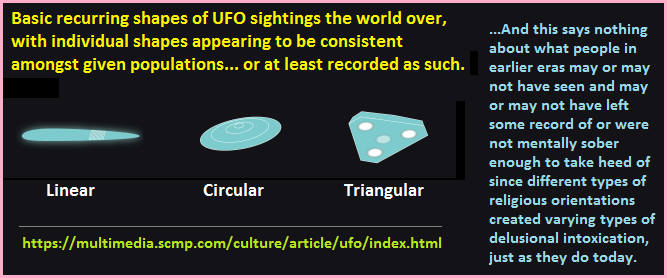
Another... more down-to-earth representation of the linear- circular- triangular geometric model can be seen in trees. For example, Lower or coastal regions tend towards the adoption of linear-like trees such as palm and banana, though exception can be found... particularly when humans intervene in re-transplanting non-native trees to different terrains and make an effort to nurture and sustain them until some measure of adaptation takes place, if at all possible. The further we go inland we find more "robust" or roundish trees and then find more triangular-shaped (such as pine) trees towards higher elevations. This is an idea which "popped" into mind several years ago, just as the image of the Pentadactyl limb representing the upper, middle, and lower classes in society had done awhile back. While it is more characteristic how poems or songs come to mind, digressions from this type of writing end up in other areas of interest.
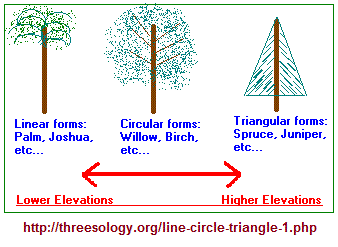
Interestingly, if we look at an island such as Hawaii and incline ourselves to think in terms of it being a microcosmic representative of macroscopic events involving larger land masses, we can indeed find the pattern along with variations involving human trans-plantation and vagaries of transplantation which might not occur normally, by way of non-indigenous species or even so-called seemingly natural weather events. (For example, if viable seeds of a tree are dropped off a ship and land on a beach, do we consider this a natural and normal event in the life-cycle of a given plant? Or what about seeds transported in the gut of a rat that jumps ship, only to land on an island where the seeds become deposited either through feces or death of the animal?)
Whereas it may be amusing for some to encounter a reference to UFO's amongst material that appears to involve a rather serious discussion, the digression is useful as a means of indicating that one's research into multiple subjects is not limited to references according to the dictates of criteria based on some assumed restriction of what information should and should not be included. However, let me regain a bit of the previous serious footing I was on by providing a and example for those readers who are fixated on finding information involving money, I offer the following illustration of linear, circular and triangular economies:
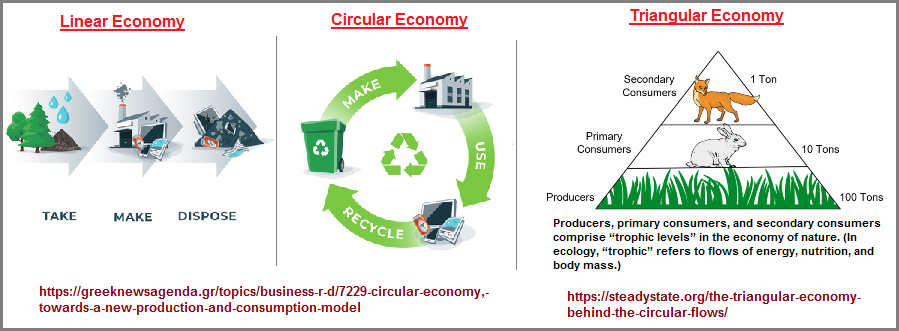
Nonetheless, despite a seemingly variation of ideas, there appears to be an inclination towards preserving cognitive profiles of compartmentalization which repeat in different subjects, and is a tell-tale indication that humanity is being subjected to environmental pressures requiring such a persistence as a survival mechanism, except that this is taking place under conditions of incremental deterioration which no current business, government or religious policy, practice or philosophy can remedy. The three larger, planetary size deteriorations (over the age of the solar system) are: 1) The Sun is burning out, 2) The rotation rate of the Earth is slowing down, 3) The Moon is receding...
To take another overlooked example of the line, circle, triangle presence... if we compare the pelvic outline of different primates, there is a distinct artistically-derivable interpretation of a developmental sequence for such geometric forms... as if Nature uses geometry (sometimes) instead of utilizing enumeration... or at least what humans can interpret as enumeration— and not only early hominid forms of cognitive activity (such as producing linear spears, using circular hammering stones, and triangular-shaped arrow/spear/knife heads). In other words, the development of human cognition (by way of examining artefacts including drawings), exhibits use of geometric forms before(?) developing the use of enumeration such as notches or dots on sticks or bones. Whereas there may have been multiple geometric configurations drawn out on the ground, this medium is not well preserved in the fossil record. Nor is the case for any expressed usage of enumeration by a forward-thinking primate in any era, suggesting they were a genius among their own respective breed. With such a scenario in mind, it is not difficult to consider that Cro-magnons may have had a superior form of counting in their respective models of tallying.
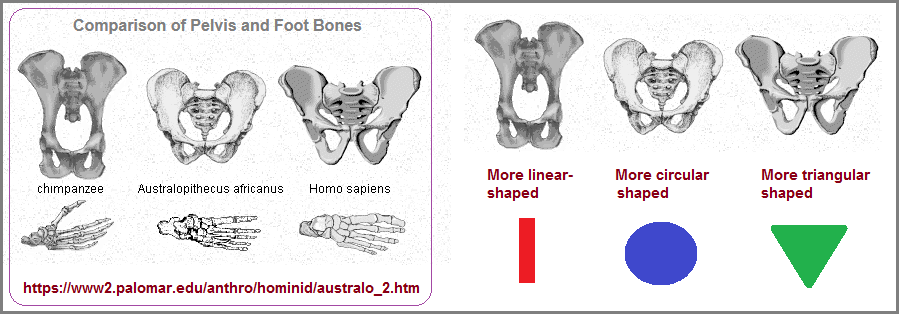
The forces of nature affect the forces of nature and it is not only humans that attempt to gain some grasp of natural events; although with respect to the limitation imposed on the design of the respective biology being used as a translation medium. Hence, the nature of a predator may thus be focused on food (prey) and self-replication (procreation) along with individualized domestics. Interestingly, the forces of nature can be represented in a variety of ways which are viewed as being useful for the interpreter, whether one uses geometry, numbers, colors, sounds or some mechanism to enhance the sensory ranges of a given biological organism with there responsive abilities to sight, sound, touch, impression, smell, taste and any extra-sensory capability. Hence in terms of the linear, circular, triangular configurations, we may note expressions which differ amongst lower and higher forms of insects, plants, aquatic animals, reptiles, mammals, primates, etc... In short, geometry appears to be a basic means of responding to environmental impressions. We see this in that which we call repetition in functionality and design.
For example, amongst higher termites we find the usage of triangular-shaped mounds. Some lower animals within their respective realm use linear-shaped burrows, while many birds resort to creating spherical or half-spherical nests, though there is a variety of types. If we take for example the shapes of eggs we find linear, circular and triangular-shaped varieties, though the labels used may suggest more than this line-up of three because the researcher is not thinking in terms of developmental design overlap, where the characteristics of two or three of the shapes can intermingle, as if to suggest traditionary trends. Whereas in my short search I did not come across an image showing or at least describing the shapes of eggs across the spectrum of all life forms, I put together a rather short list:
- Fish eggs: spherical/round
- Snake eggs: oblong/linear
- Turtle eggs: spherical/round
- Spider eggs: spherical/round or oblong/linear
- Human female (perhaps all primates?): spherical/round
- Birds eggs: oblong/linear?, round, triangular
- birds eggs: In cross section birds’ eggs are perfectly circular, but lengthwise they vary from near-spherical to elongate and often pointed at one or both ends. (the shape of birds' eggs by Tim Birkhead)
Yes, I know you can add to this list. the point being in this short list of examples is that we see a recurrence of the Linear- Circular- Triangular models, despite the difference in labels. "Oblong" suggests a linear shape to me just as "conical or pyriform" suggests a triangular shape. In general terms, the use of Linear- Circular- Triangular categories suffice to not only encapsulate all the different egg shapes, but to delineate the absence of other shapes like triangle, pentagon, octagon, etc... However, one can make a rectangle into a line depending on how long and wide one allows the shape to be included as a line or rectangle. In other words, if we were to elongate a 1 inch rectangle to the length of a foot and not alter its width, surely the image of a linear form might well come to mind. I mention this because human perception and biological activities may well differ from the perceptions of other life forms whose impressions of a given structure are subjected to a species-specific perceptual filtering system. Whereas we see a dot, an insect may well see an object they might call a circle and defend their interpretation with the same mathematical, musical, architectural, and artistic vigor as do humans when they are confronted by an interpretation which differs from their own.
Is a human-drawn line a line or is it sometimes a circular-like blotch when seen by an insect... that is if they are even aware of it as a geometrical form they are physiologically in tune with or not? For example, do bees involved with the structure of a honeycomb which humans apply mathematics to and have labeled according to the vocabulary of a given subject, see the same form and mathematical formulas, or are they so close to their work they have not the objectivity or interest in such attributions that humans apply? Is the geometric form "seen" as a whole, or do bees see only segments collated together without having any form of sentient awareness that they are creating a structure humans define to a vocabulary having no relevance to the construction of a beehive? Is the construction of a beehive like a series of humans holding hands and yet are unable to see the extent of the line unless enabled to see it from a distance? When honey bees use a characteristic "dance" (assumedly) to tell other bees the distance and direction of nectar... or at least flowers, is this the same simple type of geometric blue printing used in constructing a hive... that is, in segmented and overlapping fashion? Many things can be created by using the concepts of line, circle and triangle.
From a distance, a square pixel of an image looks like a round dot. Perhaps the so-called round Sun and Moon are actually squares? Whereas the Earth looks round from space, standing on earth one might believe it to have edges or limits, especially if one is a primitive thinking person and come upon an ocean without realizing it touches other continents. In other words, perceptions differ. This is the case when confronting research models. Even so-called experts make mistakes in perception and labeling. Very often they think in rigid terms of compartmentalizing and do not openly allow for transitional stages being expressed. Rigidity allows for specialization and thus personal ownership of a given idea or given way of interpretation, illustration, examination, as well as labeling. Whereas one person will say an egg is pear-shaped, you may prefer to say it is like a ball with a pointed end. While you are talking about the same object, both may prefer their own labels, thus trying to emphasize one is better than the other by supposedly offering a greater distinction. It is the proverbial semantic quibbling.
Let us take a look at some images describing linear and/or circular and/or triangular shapes, though different labels may be used and the idea of transitional or overlapping developmental scenarios may not be considered. In such a study, other-than egg shapes can be included such as the shapes of ears, nostrils, eyes, hair, etc, as well as gait, emotional responses, thinking patterns, etc...
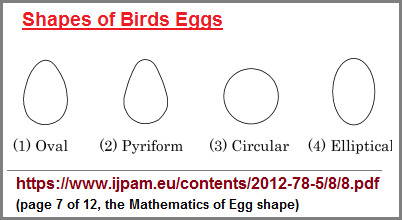

Let us now look at some shapes of human ears and nostrils ad a comparison adventure to those of egg shapes:
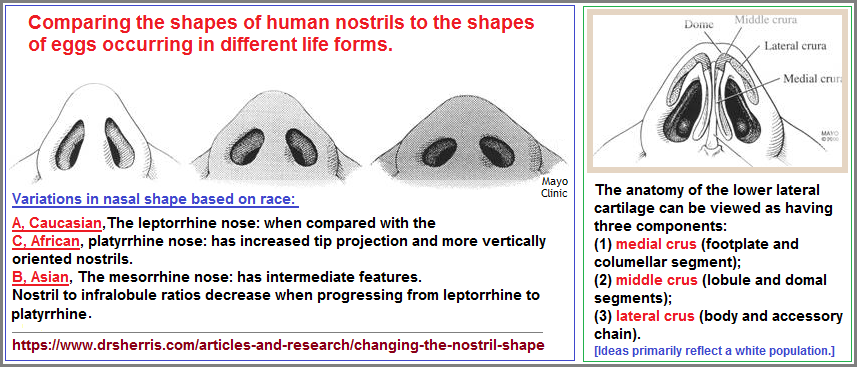
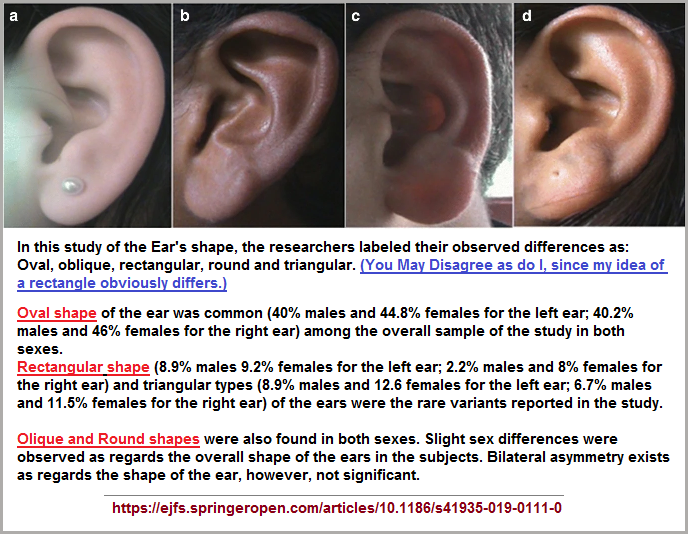
With respect to hearing, humans use three devices involving mechanical, chemical, and electrical signals. In insects, they use one or two of these referred to as by way of vibrating antenna and/or a vibrating membrane, though the notions of sound transmission can be compared with musical instruments: String vibrations, tuning fork vibrations (much like very stiff strings) and drum vibrations. Mechanically created vibrations might be said to be those instruments which involve a person blowing through a mouth piece where the air is controlled by valves or other movable obstruction covering a hole. In all cases, sound involves linear object such as an antenna, hair or leg, a circular-like object like a taut drumhead, and a triangular object-ive. (Focused sound waves can be viewed as a funneling effect similar to an invert cone or pyramidal form. I am not trying to establish labeled specificities but overall generalities.
The three principle components of brass instruments are given by the air column (waveguide), player's lips/mouthpiece (excitation source), and bell (radiation): Brass instruments
With respect to the shapes of animal ears, we generally think of ears as illustrating a triangular configuration such as those seen on dogs, cats and horses, but it depends on where one is standing and looking at which animal's ears. Indeed, we do not see rectangle nor square ears, nor regularly hear anyone speak of or draw an animal with octagon ears... unless some attempt at abstraction is being made.
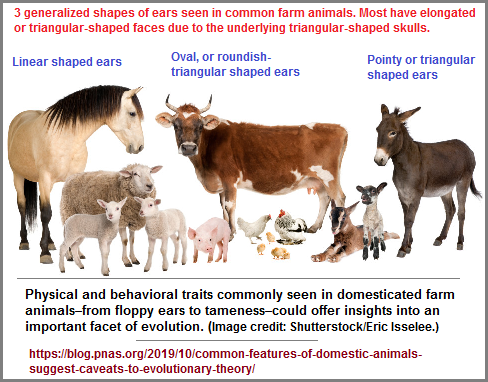
It is of interest to note that planetary bodies... at least those near to us, exhibit only the spherical/round shape, though due to planetary forces the Earth is sometimes described as a triaxial ellipsoid or squatted pear. While asteroids may appear to be a big food crumb in some configurations, we do not routinely see planetary bodies exhibiting triangular, square, rectangle or other-than roundish geometric shapes. So too are atomic particles often thought of and described. If such bodies are subjected to waves (such as electro-magnetic), the waves do not engulf a planetary body in a complete sense of exposure, There is an area behind the body-exposed wave front which may not have any waves, depending on the rate the waves and/or object are moving towards or away form each other... if not in an alternate or alternating pattern. While an object may be bathed as if a person is standing in a shower were all cavities are not submerged, the body is not soaked as if being in a bathtub. Solar (linear) waves bombarding the Earth and deflected by the Ozone do not sneak around behind the earth so as to bath the entire planet. It is more like the eye of a tornado as representative quiet area. If waves were in the shape of roundish particles, some of these might or might not roll around to the back side, but not necessarily when caught up in the vacuum of a moving stream. Nor do we think of waves as being "packets" of squares, triangles or some other geometric form. Basic forms and formulas appear to be a rule of thumb Nature abides by.
In the Fibonacci sequence, every number (after the first two) is the sum of the two preceding numbers: 0, 1, 1, 2, 3, 5, 8, 13, 21, 34, 55, 89, 144, 233, 377, 610 (The Numbers of Life by Nik Walter). Though we humans can continue the series, there apparently is no such interest in doing so by Nature. Whereas we find multiple references to a Fibonacci spiral being exhibited by Nature, it is humans imposing their impressions of a believed in power or some other significance to such a pattern. The spiral is a repeating circular pattern... and because it appears to form a swirling pattern, humans think this is appreciably more important to focus their attention on then just a simple, everyday occurrence of a circle. Yet, all circles exhibit a swirling pattern when subjected to a linear movement through space and time. While growth patterns exhibit a design suggesting an inner to an outer direction, humans don't generally interpret this to represent the pattern as a line being subjected to external (or internal) forces which pull and bend the line in an outward-directed orientation that is limited in scope. Every single example is a representation of limitation on micro- and macro-scales. If you take a particle and move it in a linear direction subjected to a surface expansion that is rotating, you get a spiral.
Yet, the distance covered before the actual turn begins differs from object to object, depending on the overall size the object will grow to. A galactic spiral is larger than the spiral of a seashell to the cochlea in a human ear, but each has its overall limitations of design it must be accommodated to. No matter how much math we wish to apply to different figures in an effort to deduce the existence of a Fibonacci sequence and rationalize significance thereto; we are eventually met with a point the object does not go beyond. All are fixated on an expressed limitation and eventual death. Observing and remaining in awe of such patterns is not a "what a ride" experience to be forever savored and reminisce about one's entire life. Metaphorically speaking, such a pattern is a mile marker for some human perceptions, but it need not be used as a corner stone that helps to erect an edifice that human comprehension, consideration and contemplations seek to remain moving in the procession of some to-and-fro dichotomy like sitting in a mental rocking chair, swing, or teeter-totter. The Fibonacci sequence is a piece of fruit or candy you may or may not want to eat (or if eaten, found to be flavorful), but in so eating it or planting it to spawn some crop which others want to purchase and thereby provides one with a sustained income; there is a time to move on to the possibility of finding more favorable condiments, fruits, vegetables or full-course meals. In short, there are other patterns to be considered.
Hence, many of the beliefs humanity is currently harboring as a presumed truth are rationalizations. Whereas one person may argue for a strict 1-2-3 or xyz representative labeling usage, another may prefer a 2,3,4 and red-yellow-green system of categorization. For example, while one person may express the recurrence of "threes" (as a general statement of observations which may in fact be more detailed), another person may claim that a sequence of "biceps, triceps, quadriceps" muscles is a refutation of a "threes" expression because it contains a pattern-of-two and pattern-of-four (in addition to a pattern-of-three). This is simply a case illustrating the logic conveyed in the Gulliver's Travels tail involving the Lilliputians, where two countries were at war over whether an egg should be broken in the middle or at an end... as a parody to the nonsense of why so many wars are fought.
In many cases there is the practice of condensation and symbolization which may be referred to as a fusion, blending, concretion, mixture, etc., Whereas instead of a set-of-three, one may describe a particular example as a trinity, or triad or triplex, Trimurti as singularities, or compounded examples as being something different if not more valuable like a transposition of two triangles to create a six-pointed star, unless one is of the disposition to focus inward on some internalized configuration such as a pentagon that some may call a pentagram and associate it with evil. However, if one is inclined to enumeration, the idea of a three-in-one which needs to be differentiated from a three-to-one ratio, though may in fact indicate a developmental transitionary phase towards a three-to-one-ratio identification. An example of a geometric three being alternatively labeled as 3-in-1 or illustrated as a triangle is the Christian concept of the Trinity whose initial origin sprang from common (Pagan) views arising out of solar worship involving the three phases or moments called dawn-noon-dusk.
The present idea of the Christian Trinity is a modernized version of ancient solar worship which preserves the "three", just as it is preserved (albeit as a three-to-one ratio) in the triplet code of DNA and genetics as well as the triplet organization in particle physics. Whereas some may want to use this as an argument for their advocacy of the Trinity, it actually is a refutation of it being a god-symbol... unless someone is presenting the Sun as being god, like ancient solar worshipers are thought to have done. Religious perceptions often flip-flop perceptions as a hold-over from an era with a predominant two-patterned mindset which enforced the perspective of mirror-image orientations constructed in a fashion similar to the yin/yang obsession; whose later development through the I-Ching revelations introduced the value of 8-trigrams, except that the trigrams were actually Bigrams... or "twos" exploring the venue of "threedom" by attaching itself to a word suggesting a three-state had been cognitively reached— but in reality had not been. The so-called I-Ching trigrams are little more than embellished Bigrams (by way of a linear repetition similar to reduplicated utterances in infant babbling whose development appears to follow a one-two-three sequencing where we can hear single, then double, then triple chunk expressions such as for example Ba... Ba-Ba... Ba-Ba-Ba..., like an unrecognized formula of early counting being cognitively exercised via a linguistic channel... without which some other type of physiological expression might take place as a compensation). Here is a short reference to the embellished Bigrams: Trigrams page 1 and another reference to the idea of embellished dichotomies (patterns-of-two): .
The "embellishment" appears to be an expression of a developmental process that can be illustrated by referring to the development of the three Germ Layers over time. The three Germ layers did not automatically show up in biological development. They occurred over time across the realm of animal development and as an isolated grouping structure as well. Let me also state that the middle layer (the mesoderm) develops last, or third, though we linguistically organize it as second. Whereas it is second in organization, it is third in the overall developmental sequence. In addition, where as the later born animal model of life forms (from Earth worms to humans) exhibit three layers and are called Triploblastic, there are animal life forms which exhibit two layers (Cnidaria and Ctenophora) and are referred to as Diploblastic. With respect to an example of an animal with only one Germ layer (Which I describe as Monoploblastic), there are some who say the sponge is the only current model, while other researchers disagree with this assessment. If if it one day decided against the Sponges being an example of Monoploblasticism, this does not refute the idea that there may well have been an extent animal life form which came from one Germ layer. Hence, we see a one- two- three developmental sequence where overlapping no doubt came into play, as well as hit and miss precursor developmental scenarios suggesting the idea of embellishment from one stage to the next.
For example, just because multiple religions have or have had an orientation focused on the value of "seven", does not mean this example alone is sufficient to explain the usage, and neither does one's appeal to the "god did it" statement; which is an excuse being provided by those not actually interested in finding out whether a given religious interest began internally or external to any religious dogma... verbalized or written. Apparently, the interest in the number seven used by religions are due to internalized dispositions of creation, and not represented in the Nature which religious thinkers of old (before any internally used "7" patterns were used), did not write or speak about, and were likely not intellectually privy to, just as scientists of today were not privy to the seven patterns being encountered in their work such as the proposed 7 colors of the rainbow within the visual spectrum.
In my own interests for portraying different examples from different subjects which reflect the three-patterned ensemble of a "one-two-many" profile, I like to look at basic patterns from different subjects in an effort to one day be able to at least give some possible explanation as to why recurring patterns crop up that (apparently) do not have a cultural bias... though biases of thought for a given subject can be used the world over by all cultures. Nonetheless, by looking at basic biology, basic physics, the origin of this, of that, and whatever one might find an extended interest in for a given time and effort; we can provide others with examples that seem to represent some early disposition. However, if the human brain is born with a survival need to see recurring patterns, then this will be the patterns most likely to be prominent. With this said, the many ideas which we humans have may only be in the form they are because they provide some semblance of survival in our particular era... unless of course what we think we see in terms of a given pattern is correct and not merely something we impose on our perceptions.
In my search for "threes", I come across multiple other patterns, but in using the word "multiple" I mean only a handful and not an unlimited quantity. Just like DNA presently limited to the usage of a triplet code and the Periodic Table of Elements limited to less than 20 at the present time (not including artificialized designs), there appears to be limitations of the patterns our minds resort to time and again, which provides us with the suggesting that human imagination may also have its limitations just as the limitations of "records" being set by athletes. It is widely considered that humans may be at or close to the maximum reach of human physiology. This then may be true with human mental functioning as well. Instead of reaching a new horizon as a pristine expression, what we have are hybrids of previous patterns already established. Indeed, more often than not we have repetition and re-runs or sequels being seen in religion, business, and politics... as well as sports, academic achievements, music, art, acting, dance, criminal science, etc... And no matter how one wants to believe change occurs, the perceptions of many are deluded by a change in the wardrobe of a given person, place or thing. A good example is when a politician uses the word "change" in their campaign, only to mean that the incumbent is to be changed by them being elected, but the same type of political nonsense continues unabated because the underlying formula of governance is deteriorating and unsuitable for humanity to pursue an actual gain of individual and collective development. All forms of government and religion and most businesses, are presently existing in a mode of personal self-survival that is detrimental to an actual supportive role for human developmental prosperity beyond the constraints of an incrementally deteriorating planet, solar system and galaxy.
Our current models of mathematics are part of the problem as well. It too is in a self-survival mode like someone claiming themselves to be too important not to receive an appreciable level of deference and status that it must survive and thus be enforced on the psyche of everyone through an education process which inclines everyone to believe it is totally indispensable... just as the ancient Language of Latin was at one time perceived to be a necessity. In many respects, Mathematics has become the new Latin the way it is being taught by many instructors and its usage as a Model Language of choice to be applied to all genres of thought processing. To be without it one is thought unable to think logically enough to grasp presumed higher cognitive processing skills required for advanced courses which overlook the fact that mathematics exhibits similar basic cognitive patterns as other subjects, and is but another representative example of a standard cognitive model which may be little more than a reflexive survival reaction exhibited by the larger social structure attempting to maintain some semblance of equilibrium in an incrementally deteriorating environment whose deteriorations are increasing due to an over-population as well as a decrease in planetary resources as part of and distinct from the activities of humanity.
To say the least, it is difficult to use mathematics to describe, much less solve a numerically identified circumstance if and when mathematics adds to the problem because its own underlying basic patterns impose themselves on perceptions as well.
With respect to the initial anatomical images regarding a standard cognitive model seen in the basic Pentadactyl limb configuration, let me provide some examples from basic biology:
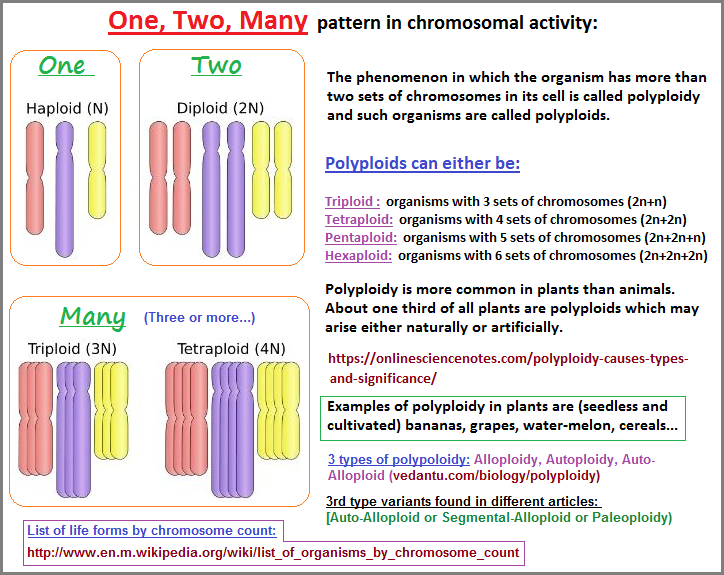
Let us look at least one compilation concerning a List of chromosome counts in different life forms. Interestingly, humans have 46 (twenty three from each parent), which correlates (roughly)...
- with the 23.5 tilt of the Earth's axis (though it is said to roughly vary between 21 and 24 degrees) and...
- the sequence of a reversed polarity...
...effectively suggesting a human-selective sensitivity or disposition to become influenced by an environmental event with a large magnitude,(that is if biological activity is influenced by recurring environmental patterns as suggested by the two-patterned night/day sequencing and other biological cycles seemly tuned to other environmental patterns).
If the split between humans and other primates occurred... let us say 6- 7+ million years ago, we need to see whether the tilt of the Earth began to lessen towards a (approximate) 23 degree range from a larger range such as a more prominent 24 degree tilt for the evolutionary development of the human lineage. In other words, did earlier born primates (such as Chimps, Orangutans, Gorillas) developmentally experience an environmental influence in which there existed an Earth axial tilt that was sustained more so in 24 degrees then the 23 degree range of later born (Neanderthals, Denisovan, Cro-Magnons, present day) humans? And let me emphasize developmentally to offset knee jerk responses from those who may be inclined to impulsively react and state objections to the presence of primates in a 23 degree tilt whose chromosome count does not change... at least not on time scales which present humans are accustomed to think about concerning themselves and overt responses to large magnitude weather and geological events such as earthquakes, tsunamis, tornadoes, etc...
Date of (series) Origination: Saturday, 14th March 2020... 6:11 AM
Date of Initial Posting (this page): 1st March 2022... 6:04 AM
Re-Posting:Saturday, 6th August 2022... 10:34 AM